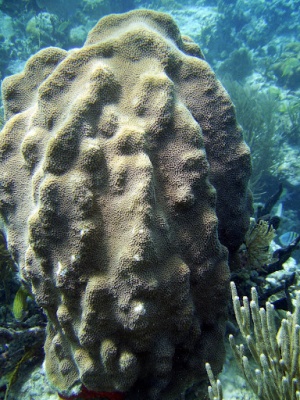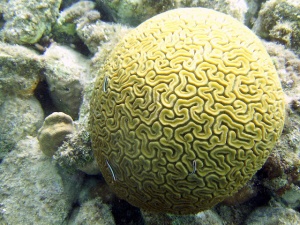FringingReefs: Difference between revisions
No edit summary |
No edit summary |
||
| Line 8: | Line 8: | ||
According to [[DarwinsTheory|Darwin's Theory]], fringing reefs are formed around a volcanic island. The coastline is generally shallow and gently sloping, perfect for rapid calcium carbonate growth. As time progresses and the island submerges, a lagoon is formed between the land mass and the coral platform. This is then known as a [[BarrierReefs|Barrier]]. | According to [[DarwinsTheory|Darwin's Theory]], fringing reefs are formed around a volcanic island. The coastline is generally shallow and gently sloping, perfect for rapid calcium carbonate growth. As time progresses and the island submerges, a lagoon is formed between the land mass and the coral platform. This is then known as a [[BarrierReefs|Barrier]]. | ||
==Fringing Reef Morphology== | ==Fringing Reef Morphology== | ||
| Line 14: | Line 13: | ||
A fringing reef can be broken into three main areas: the reef flat, the reef front, and the outer reef slope. Depending on the erosional forces, water temperature, and depth, these areas develop distinct characteristics and marine life.<ref name="starfish"> Zubi, Teresa. “Reef Morphology.” Starfish.ch. 27 Feb. 2013. Web. 16. Apr. 2013. </ref> | A fringing reef can be broken into three main areas: the reef flat, the reef front, and the outer reef slope. Depending on the erosional forces, water temperature, and depth, these areas develop distinct characteristics and marine life.<ref name="starfish"> Zubi, Teresa. “Reef Morphology.” Starfish.ch. 27 Feb. 2013. Web. 16. Apr. 2013. </ref> | ||
[[File:fringingmorphology.png|500px|left|thumb|red = coarse sedimentation dark orange = fine sedimentation yellow = daily variation of temperatures orange = number of different species (image credit: Teresa Zubi)]] | |||
'''Reef Front''' | '''Reef Front''' | ||
'''Reef Flat''' | |||
'''Outer Reef Slope''' | '''Outer Reef Slope''' | ||
<br clear=all> | |||
==Where are they found?== | ==Where are they found?== | ||
Revision as of 19:08, 17 April 2013
Fringing Reefs
Fringing reefs or shore reefs grow parallel to the shoreline in warm, shallow water. They need abundant sunlight and a suitable hard bottom. It is also important that the water has low nutrient levels and low turbidity. Runoff or excessive sediments (like after a storm) may inhibit growth.[1]
Formation
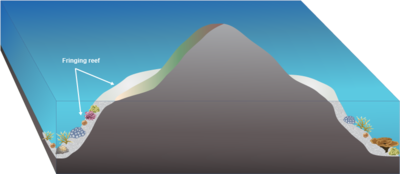
According to Darwin's Theory, fringing reefs are formed around a volcanic island. The coastline is generally shallow and gently sloping, perfect for rapid calcium carbonate growth. As time progresses and the island submerges, a lagoon is formed between the land mass and the coral platform. This is then known as a Barrier.
Fringing Reef Morphology
A fringing reef can be broken into three main areas: the reef flat, the reef front, and the outer reef slope. Depending on the erosional forces, water temperature, and depth, these areas develop distinct characteristics and marine life.[2]
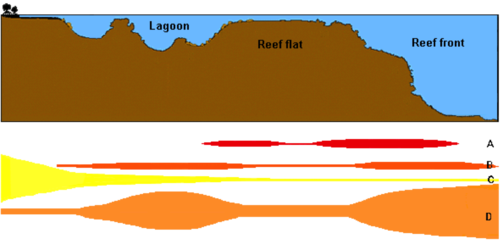
Reef Front
Reef Flat
Outer Reef Slope
Where are they found?
Since fringing reefs often form around the perimeters of newly developing islands, they are common across the subtropical region, having large expanses off the Western coast of Australia, the Carribbean, the Red Sea, and the Indo-Pacific.[1] The map below shows the location of corals classified by reef type. The red dots represent fringing reefs.
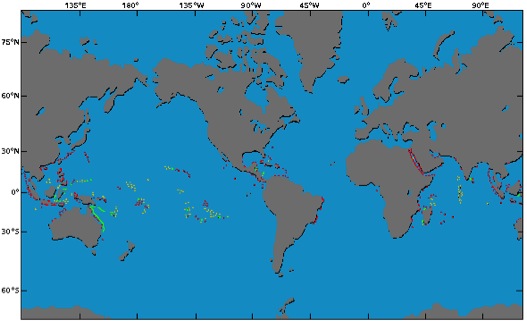
The Ningaloo Reef is largest fringing reef in the world, stretching 260 km along the western coast of Australia. It is a very popular destination for snorkelers and scuba divers because of its proximity to the shore. Unlike the Great Barrier Reef which must be accessed by boat (remember, fringing reefs are close to shore and barrier reefs are separated by a lagoon), it is possible to swim out to the Ningaloo reef.
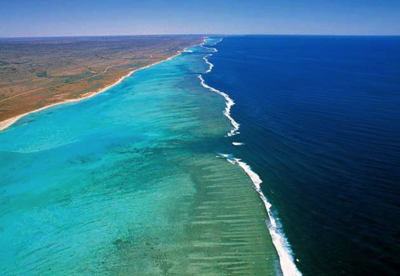
What will I see?
Boulder star and brain corals are the major species of corals found in fringing reefs.[1]
